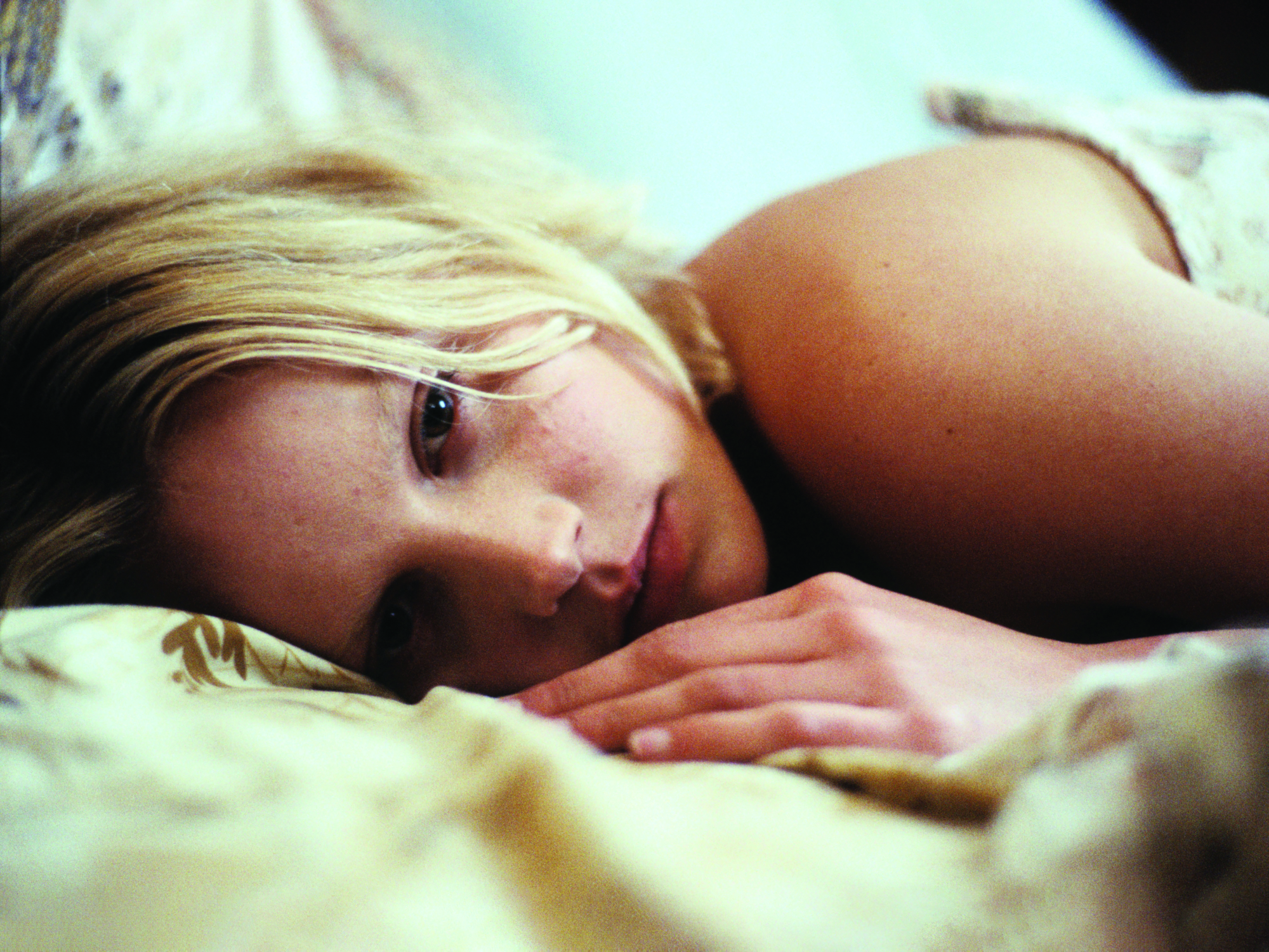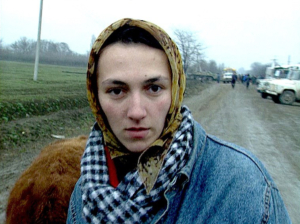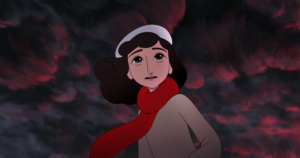In 2010, as the US Academy of Motion Picture Arts and Sciences was congratulating itself for finally anointing a woman, Kathryn Bigelow, as Best Director, its Australian counterpart had already bestowed its equivalent award on no fewer than eight female filmmakers. Starting with Gillian Armstrong’s success in 1979, subsequent AFI (later AACTA) awards for Best Director had been presented to Nadia Tass, Jocelyn Moorhouse, Jane Campion, Sue Brooks, Sarah Watt, Elissa Down and – at that time, most recently – Cate Shortland for her debut film, Somersault (2004).[1]In the last decade, Jennifer Kent (on two occasions) and Shannon Murphy have also gone on to receive the award.
Yet this statistic – incredible in contrast – presents nothing like the complete picture of women in Australian film, which has always been complex and fraught with challenges. As lazy and redundant as it is to distil such diverse and idiosyncratic works into a single genre based solely on gender, it is precisely this idea of a definable female sensibility that has seen the parameters of Australian film expand and shift. In an editors’ preface to the seminal 1987 essay anthology Don’t Shoot Darling! Women’s Independent Filmmaking in Australia, Annette Blonski, Barbara Creed and Freda Freiberg explain that:
So much of women’s work has gone unrecorded and unmarked; so much of our history exists merely as footnotes to accounts of the exploits of famous men. It has become a significant part of the modern feminist project to recover our history, and to write it ourselves.[2]See Annette Blonski, Barbara Creed & Freda Freiberg (eds), Don’t Shoot Darling! Women’s Independent Filmmaking in Australia, Greenhouse Publications, Richmond, Vic., 1987, preface.
This unrecorded history is one of exclusion and erasure, which both conceals the work of women in cinema and discourages more women from participating in the industry. It also sets the stage for the world of Somersault, a film that closely examines the coming of age of a complex female character, and doesn’t flinch from the complexities it finds there.
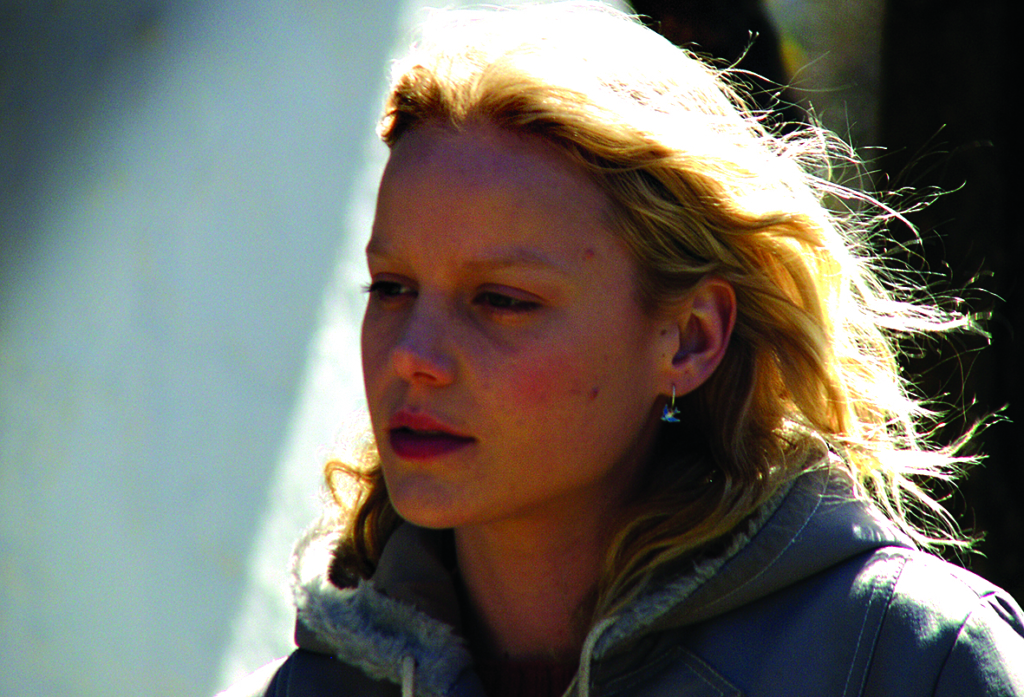
After graduating from the Australian Film Television and Radio School and winning the Southern Star Award for most promising student, Shortland created local and international buzz with her short films Flowergirl (1999) and Joy (2000). Then came Somersault – an unusually polished and accomplished debut feature.
After being caught kissing her mother’s boyfriend, teenager Heidi (Abbie Cornish) flees her Canberra home and takes a bus to the foot of the Snowy Mountains to follow up a job offer that doesn’t eventuate. She spends her time roaming the frigid countryside in and around the town of Jindabyne, seeking employment opportunities and human connection, ultimately meeting Joe (Sam Worthington), the son of a local wealthy farmer. ‘I’ve done bad things,’ she warns him.
Joe’s attraction to Heidi is unmistakable, yet he remains emotionally unavailable to her. ‘Am I your girlfriend?’ she innocently asks on their second date, following up his perplexed reply in a manner that’s both naive and astute, teasing and cutting: ‘You’re just too scared to say it.’ Heidi provokes him further by swallowing a bowl of hot chillis in a way that’s equal parts bravery test and self-harm.
Offered a place to stay by Irene (Lynette Curran), a local motel operator, and a job at a local petrol station alongside Bianca (Hollie Andrew), Heidi continues to press buttons, pulling people close to her only to push them away. Rejected by Joe and sensing her new world implode, she finds herself drunk and naked alongside two tourists, who attempt to take advantage of her fragile and compromised state.
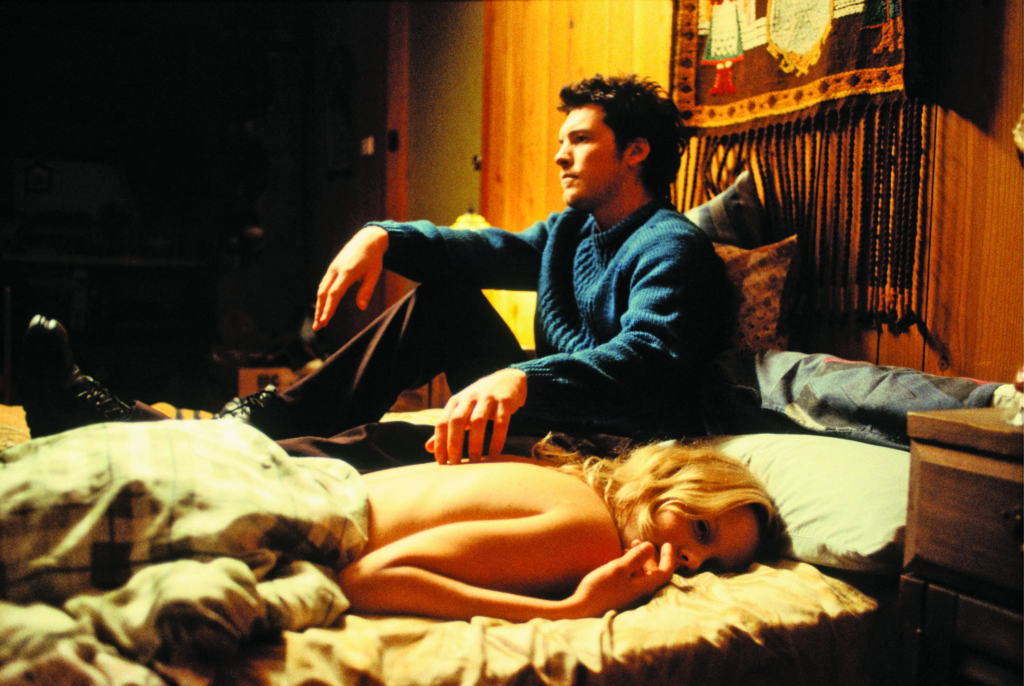
When she’s saved by Joe, he asks her: ‘Do you know how fucked up you are?’ Despite her inebriated state, she rejects his pity and highlights his hypocrisy in failing to acknowledge his own arrested development: ‘If you’re close to people […] you tell them things, and you know that, no matter what, they’re still gonna love you.’
Although the film is committed to its focus on Heidi, it takes time to look compassionately at Joe’s sexuality too, suggesting that identity and belonging are both gendered and hopelessly intermixed. In a surprising subplot, Joe initiates a kiss with Richard (Erik Thomson), a gay man temporarily returning to Jindabyne, only to be rebuffed. This subplot demonstrates Shortland’s keen sense of irony; earlier in the film, Heidi tells Joe, ‘You can’t tell what people are like by looking at them.’
Irene finally calls Heidi’s mother to come and collect her, and the final scenes of the film focus on her farewell to Jindabyne and to Joe. Despite their short-lived affair, both are changed by the experience. ‘I think it’s good that we met,’ she tells him, leaving him to contemplate his fallibility, his sexuality and his future in a town that he calls ‘the smallest, most bullshit part of the world’.
At the core of Somersault is Shortland’s deep compassion for her characters. The film is proof of the old adage that you can’t run away from your problems. Yet, ultimately, Somersault is about forgiveness and its role in redemption and growth; Shortland exposes her characters’ flaws, true, but always without condescending to them or moralising for the audience.
Pessimism and hyperbole about the so-called decline of the Australian film industry had very little to do with Shortland’s film, and unfairly overshadowed what is a delicate, visually haunting and exquisite movie.
Although Shortland’s film fits into the well-established coming-of-age genre, it certainly doesn’t sit neatly. Superficially, it shares qualities with other Australian films with teenage female protagonists, such as Puberty Blues (Bruce Beresford, 1981) or Looking for Alibrandi (Kate Woods, 2000), but Heidi’s story shows that, within that genre, there is room for many kinds of female characters and female-driven stories.
When adolescent female sexuality is depicted on screen, it often falls into the tired tropes of the ‘Lolita’ archetype or the underage femme fatale, as in Poison Ivy (Katt Shea, 1992) or Pretty Persuasion (Marcos Siega, 2005), or else positions such characters as tragic, exploited victims, as in Thirteen (Catherine Hardwicke, 2003) or The Virgin Suicides (Sofia Coppola, 1999). But Heidi’s sexuality is nothing if not an active, centred presence in the story. Detached from the male gaze and under Shortland’s deft hand, Heidi perfectly encapsulates the age when teenagers are still trying on their sexuality, recognising its currency but not yet in control of it. Although Heidi is nothing if not a determined survivor, there is also more to her character than strength, and her choices run the gamut from dangerous to clumsy.
This can make for very uncomfortable viewing, and is likely to produce a visceral reaction from a range of viewers. There’s no question that the way Heidi is depicted is powerfully gendered. Lisa French, in her study of Australian film Does Gender Matter, argues that local cinema has benefited enormously from a generation of female filmmakers who have often been uncompromising in their quest to depict their own lived experiences on screen. As French explains, ‘Women naturally tell stories linked to their (female) experience of the world, and these are not stories that men would necessarily be likely to tell or be able to tell from an authentic female perspective.’[3]See Lisa French, ‘Does Gender Matter?’, Lumina: Australian Journal of Screen Arts and Business, no. 14, May 2015, p. 145. For her, such stories can result in a ‘shock of recognition’[4]ibid., p. 147. for female audiences. French recounts times in watching films when she ‘identifies with something that is difficult to pin down but which connects to being female [… It’s] a shock because these textures are so rare and I recognise them as emerging from experience I understand.’[5]ibid.
When discussing her inspiration for Somersault, Shortland remarked that ‘it was a combination of landscape and disturbed children’.[6]Cate Shortland, quoted in Hopscotch Films, Somersault press kit, 2004, p. 5. Landscape is a common focus of Australian film, a feature with its own history as a complex and ever-changing site of settler–sovereign relations. Yet when Somersault screened at the Edinburgh International Film Festival, the program asked: ‘Is it short-changing Australian cinema to note that this first feature doesn’t actually resemble an Australian film? […] It actually plays like a European art-movie, something French and feted.’[7]Quoted in ibid., p. 30.
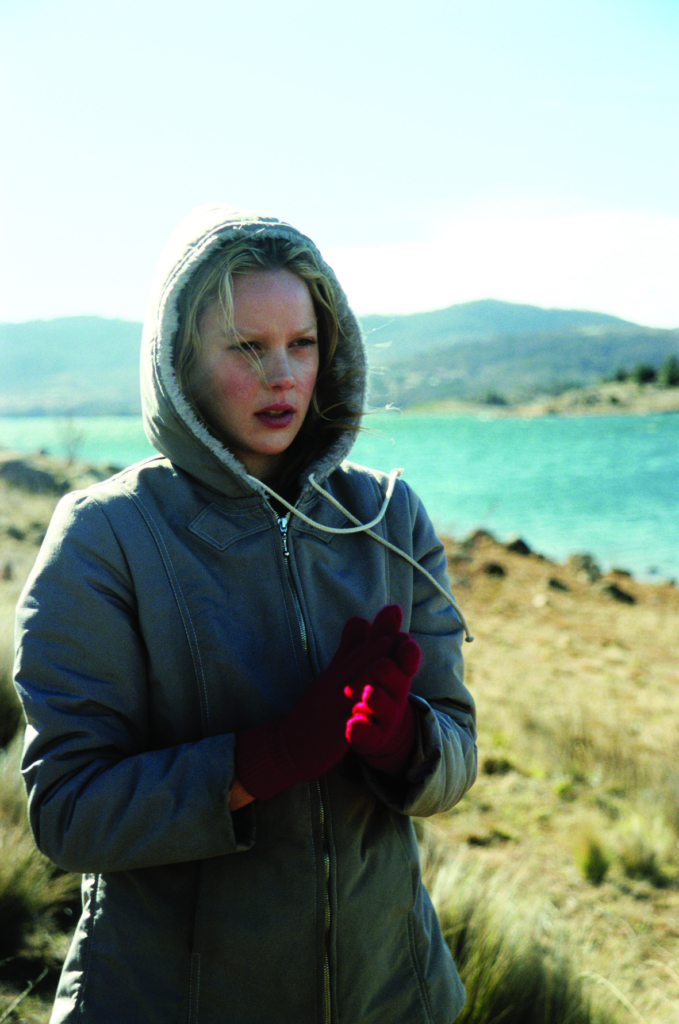
When Australian movies so often use the hot, dry Australian interior as a setting, it is quite startling to see Australian snowdrifts on screen. According to Shortland,
I always wanted the film to be shot in winter. I had these images of people’s breath, floating on the air. And it’s that fragility and the sharp clearness of the environment that you feel when you are in a cold climate.[8]Shortland, quoted in ibid., p. 15.
Yet Somersault is not just a geographical excursion but also a sensory one. The film’s director of photography, Robert Humphreys, uses a handheld camera to follow Heidi as she explores her new surroundings and to share her childlike wonderment at what she sees. Firmly situated from Heidi’s perspective, the camera captures the crisp, cold terrain of the film’s small-town setting in deliberately muted tones of grey and blue – coincidentally, a similar approach to the one used by director Ray Lawrence soon after for his feature shot in the same location, the aptly titled Jindabyne (2006).
Humphreys juxtaposes the wintry terrain with warmer, richer colour palettes for interior shots, including deliberate jolts of red. In pre-production, he and Shortland were careful to plan out drops of fiery, passionate reds every couple of scenes, from gloves and thermals to chillis and a car’s tail-lights – another technique that forces us to share Heidi’s point of view. Heidi sees beauty in even the most mundane of everyday items, from a new pair of mittens to a stolen beer coaster. She traces her fingers over objects and pastes keepsakes into a scrapbook. In many ways, she shares her state of wonderment with the iconic schoolgirls of Peter Weir’s Picnic at Hanging Rock (1975): like Heidi, also white, teenage, female protagonists who traverse an Australian landscape – albeit a very different one – in search of the answers to life’s mysteries. Perhaps in a deliberate nod to Weir’s film, Shortland cast Anne-Louise Lambert, who plays Miranda in Picnic at Hanging Rock, as Joe’s mother in Somersault.
Instead of an internal monologue, Shortland uses the ethereal soundtrack of Sydney band Decoder Ring to underscore Heidi’s journey. From the breathy, often childlike female vocals to the haunting piano and delicate percussion, the music perfectly encapsulates the ambience of Heidi’s reverie. One track, titled ‘Music Box’, uses a simple xylophone to accentuate the foothills of the Snowy Mountains as Heidi’s new playground. As she traverses the perimeter of Lake Jindabyne, she sings a children’s clapping song to herself. In line with Shortland’s commitment to empathy for her characters, she doesn’t let us forget that coming-of-age stories are about very young people – ‘disturbed children’ indeed, in this instance.

Somersault screened as part of Cannes Film Festival’s Un Certain Regard sidebar in 2004, and later scooped the pool at the AFI Awards ceremony in 2005. Including Shortland’s prize for Best Director, it won a stunning thirteen AFI Awards – a sure recipe for backlash in Australia, where commentators are always on the alert for tall poppies. Several arts journalists and political columnists saw Somersault’s wins as a testament to a weak year in homegrown cinema rather than a confirmation of the film’s quality. In response to its fifteen nominations – which was itself a record – critic Jim Schembri published an article in The Age with the title ‘Crappy Days Are Here Again’. Schembri disparaged Shortland’s film as a ‘dreary opus’ that ‘was indulged with a singularly ridiculous amount of media publicity that truly boggled the mind’.[9]Jim Schembri, ’Crappy Days Are Here Again’, The Age, 29 October 2004, <https://www.theage.com.au/entertainment/movies/crappy-days-are-here-again-20041029-gdyvy6.html>, accessed 13 September 2020. This sentiment was soon echoed by right-wing commentator Miranda Devine, who brought up Somersault’s success to lament the state of the Australian film industry in The Sydney Morning Herald. Devine, not a film critic, called Somersault ‘simply unwatchable’, and approvingly cited a friend’s reference to the AFI Awards ceremony as ‘a Potemkin village erected by the industry to hide its shame’.[10]Miranda Devine, ‘Cinemagoers Give It a Miss as Film Industry Loses Plot’, The Sydney Morning Herald, 10 December 2006, <https://www.smh.com.au/opinion/cinemagoers-give-it-a-miss-as-film-industry-loses-plot-20061210-gdp0qr.html>, accessed 13 September 2020.
Such pessimism and hyperbole about the so-called decline of the Australian film industry had very little to do with Shortland’s film, and unfairly overshadowed what is a delicate, visually haunting and exquisite movie. Ironically, many international critics seemed to recognise these qualities more astutely than many local reviewers did.[11]See, for example, Stephen Holden, ‘Somersault, the Story of an Alluring Teenage Runaway’, The New York Times, 21 April 2006, <https://www.nytimes.com/2006/04/21/movies/somersault-the-story-of-an-alluring-teenage
-runaway.html>; and Dave Calhoun, ‘Somersault’, Time Out, <https://www.timeout.com/movies/somersault-1>, both accessed 3 February 2021.
Both Cornish and Worthington saw their work in Somersault serve as a stepping stone to Hollywood. While Cornish has gone from strength to strength, most notably as Fanny Brawne in Bright Star (Campion, 2009), no other director has since captured Worthington’s charms quite like Shortland. In Somersault, Worthington’s Joe presents a unique kind of machismo – one that examines, dismantles and subverts itself as a subtle counterpoint to Heidi’s story. In Hollywood, however, Worthington seems stuck in a cycle of blockbuster films that seem more interested in projecting machismo as cliché. But there is no doubting his knack for drawing lucrative roles, such as in James Cameron’s Avatar (2009) and its forthcoming sequels. Shortland, meanwhile, has established a career as a director of respected and well-received independent films, taking Australian cinema to Germany for both Lore (2012) and Berlin Syndrome (2017). Most recently, she has been hired by Marvel Studios to helm Black Widow (2021), a film that will be keenly observed as a possible corrective to the testosterone-driven world of headline superheroes.
Among other things, then, Somersault stands as a powerful introduction to at least three unique talents. Its lingering effects – part fever dream, part sensory plume – are a testament to their skills. When Joe describes Heidi’s allure in the film, he asks, ‘When you were a kid, did your mum ever used to spray perfume in the air and sort of walk through it? She’s like that.’ It’s a simile that works as much for Shortland’s debut film as for her central character.
Endnotes
| 1 | In the last decade, Jennifer Kent (on two occasions) and Shannon Murphy have also gone on to receive the award. |
|---|---|
| 2 | See Annette Blonski, Barbara Creed & Freda Freiberg (eds), Don’t Shoot Darling! Women’s Independent Filmmaking in Australia, Greenhouse Publications, Richmond, Vic., 1987, preface. |
| 3 | See Lisa French, ‘Does Gender Matter?’, Lumina: Australian Journal of Screen Arts and Business, no. 14, May 2015, p. 145. |
| 4 | ibid., p. 147. |
| 5 | ibid. |
| 6 | Cate Shortland, quoted in Hopscotch Films, Somersault press kit, 2004, p. 5. |
| 7 | Quoted in ibid., p. 30. |
| 8 | Shortland, quoted in ibid., p. 15. |
| 9 | Jim Schembri, ’Crappy Days Are Here Again’, The Age, 29 October 2004, <https://www.theage.com.au/entertainment/movies/crappy-days-are-here-again-20041029-gdyvy6.html>, accessed 13 September 2020. |
| 10 | Miranda Devine, ‘Cinemagoers Give It a Miss as Film Industry Loses Plot’, The Sydney Morning Herald, 10 December 2006, <https://www.smh.com.au/opinion/cinemagoers-give-it-a-miss-as-film-industry-loses-plot-20061210-gdp0qr.html>, accessed 13 September 2020. |
| 11 | See, for example, Stephen Holden, ‘Somersault, the Story of an Alluring Teenage Runaway’, The New York Times, 21 April 2006, <https://www.nytimes.com/2006/04/21/movies/somersault-the-story-of-an-alluring-teenage -runaway.html>; and Dave Calhoun, ‘Somersault’, Time Out, <https://www.timeout.com/movies/somersault-1>, both accessed 3 February 2021. |
